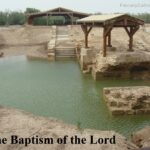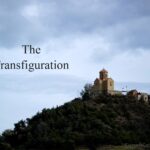
Before beginning his public ministry, Jesus was baptized in the Jordan River by John, his relative. This baptism by John had been a baptism of repentance but Jesus had no sins to repent of.
Not needing to be baptized for his own benefit, He humbled Himself and was baptized out of love for man and obedience to God the Father.
The water of Jesus’ Baptism did not cleanse Him. Instead He cleansed the water so that Christian disciples could be baptized in this water after Him so that their sin could be removed.
By lowering Himself among sinners and being baptized, Jesus shows his followers what they must do to be saved. His Baptism also reveals the gifts of sonship and kingship given to Christians by God through Baptism.
All three Persons of the Holy Trinity, the Father, the Son, and the Holy Spirit, are present at this event, emphasizing its significance in the life of Jesus Christ.
Catholics meditate on the Baptism of the Lord in the Jordan River in the First Luminous Mystery of the Rosary.
Connecting the end of the Christmas season and the beginning of Ordinary Time, the Feast of the Baptism of the Lord is celebrated on the Sunday after the Feast of the Epiphany, or on the Monday after Epiphany in the United States.
John hesitated to baptize Jesus:
Jesus did not need to be baptized:
Jesus had no sin to be removed:
Then Jesus came from Galilee to John at the Jordan to be baptized by him. John tried to prevent Him, saying, “I need to be baptized by You, and yet You are coming to me?” Jesus said to him in reply, “Allow it now, for thus it is fitting for us to fulfill all righteousness.” Then he allowed Him. After Jesus was baptized, He came up from the water and behold, the heavens were opened [for Him], and He saw the Spirit of God descending like a dove [and] coming upon Him. And a voice came from the heavens, saying, “This is my beloved Son, with Whom I am well pleased.”
Matthew 3: 13-17
Jesus allowed Himself to be numbered among sinners:
Revealing his identity and restoring ours:
Basically, the whole mystery of Christ in the world can be summed up in this term: “Baptism”, which in Greek means “immersion”. The Son of God, who from eternity shares the fullness of life with the Father and the Holy Spirit, was “immersed” in our reality as sinners to make us share in his own life: He was incarnate, He was born like us, He grew up like us and, on reaching adulthood, manifested his mission which began precisely with the “baptism of conversion” administered by John the Baptist. Jesus’ first public act, as we have just heard, was to go down into the Jordan, mingling among repentant sinners, in order to receive this baptism. John was naturally reluctant to baptize him, but because this was the Father’s will, Jesus insisted.
Pope Benedict XVI, Homily, 13 January 2008
Jesus’ Baptism is linked to his Crucifixion:
Jesus’ Baptism foreshadows his death on the Cross:
Jesus’ public life begins with his Baptism by John in the Jordan. John preaches “a baptism of repentance for the forgiveness of sins”. A crowd of sinners – tax collectors and soldiers, Pharisees and Sadducees, and prostitutes- come to be baptized by him. “Then Jesus appears.” The Baptist hesitates, but Jesus insists and receives Baptism. Then the Holy Spirit, in the form of a dove, comes upon Jesus and a voice from Heaven proclaims, “This is my beloved Son.” This is the manifestation (“Epiphany”) of Jesus as Messiah of Israel and Son of God.
Catechism of the Catholic Church 535
The Baptism of the Lord is a precious mystery of the Church:
The Jordan River is significant in the history of salvation:
The Truth, Goodness, and Beauty of the Catholic Church
Priests don’t just happen:
Share this page with friends and family to start a conversation about your faith.
Don’t miss a post. Learn more about the Catholic Church and strengthen your Catholic faith.
Find more Fiercely Catholic video issues here.
Subscribe here.


